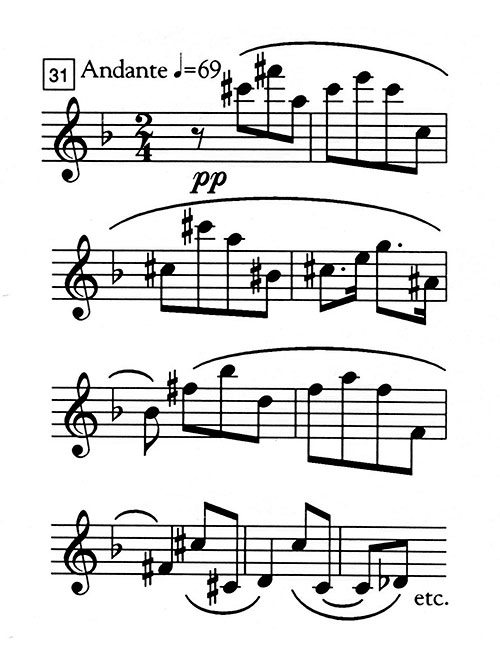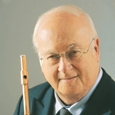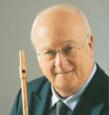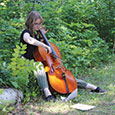Lips are too often considered the most important part of tone production, because it is at their level that air becomes musical sound. The lips are not the only element to produce the tone. The air brought by the air column breaks upon the outer edge of the embouchure hole and creates flute sound.
The lips should not produce any effort. They act as guide and control. Without any stress, and with very little movement, one can play chromatically the whole range of the flute without moving the lips. Why should it be different in arpeggios and wide intervals? Because we cannot move the lips on every note during fast passages, there is no reason to do so in slow phrases. It is the speed of the air that allows the shift between registers.
Many players worry about their chops and only that: they are forever touching them, looking at them, and trying new headjoints. They are like drivers who consider the steering wheel the most important part of an automobile.
The lips should direct the air effortlessly. They need protection, however, especially in the bitter wind of the American winter. Lipstick or lip ointment help, and some professional players apply lipstick just before performing.
If the mouth is dry, the lips usually dry out as well. Small sips of slightly sweetened spring water at room temperature should help quench the thirst, but try to avoid ice-cold tap or drinking fountain water that contain purifying chemicals such as chlorine. Stay away from carbonated beverages, of course. Gas has a tendency to come right back up at the wrong moment. The air column produces the energy of playing while the lips provide control and direction, but not force.There is no ideal lip position. If a teacher tries to change a student’s lip geometry, it may be a disfavor. Symmetry has nothing to do with it, because the flute is played in an asymmetric position. Each lip morphology is unique in shape, thickness, size, and firmness. More important is the way the lips are used as a guide. Comfort is the issue, within reasonable proportions. If it works, do it.
The character of tone lies in the way the musician hears and how the air column resonates. As Adolph Herseth, principal trumpet of the Chicago Symphony Orchestra said in Smithsonian (1994), "You can only reproduce the tone that you hear inside of yourself. Embouchure technique comes from what you want to hear, not the other way around."
By always striving to shape the tone with the lips, the weak muscles of the mouth become overworked and fatigued. Instead of improving the tone, placing too much emphasis on the lips can result in a playing paralysis. In reality, the lips should not produce any effort. Their mission is to lead the air column to the breaking edge, the outer rim, of the embouchure hole. The energy of the air (speed and pressure) derives from many factors, but not the lips. Once the supported air column hits the embouchure hole, it produces a sound that resonates, but not the lips.
A lip technique that works in practice without stress but is unreliable under nervous pressure is counter-productive. Technique should respond to musical needs under unfavorable circumstances, not conform to a laboratory theory. The lips should stay practically still and flexible, in the same general position, whatever the range, dynamic, intonation, or projection problem. The old French methods, such as Henri Altes‘ Celebre Methode de Flute, taught that the lips should keep the position they have when trying to spit a fig pit or a tea leaf from the tip of the tongue. It is simple and still valid: the lips should be moderately pulled in a half smile to conduct the air stream effectively and effortlessly. The sound’s energy comes from elsewhere.
Pinching the lips, as well as jutting the chin, to reach high notes are useful for beginners, but, as soon as the techniques of support and appoggio are understood, there should be less effort on the lips and no sound of air leaking.
Conversely, the fashion of a completely loose embouchure, with mouth comers drooping, gives a false impression of relaxation: it does not help control, produces turbo-sound, and, through its instability, increases stress.
Even though these views run against the prevailing ideas of some flutists, I believe that lip gymnastics are harmful; a comfortable lip position in the mid-range applies well in all registers; and the sound is not generated by the lips but within the body of the flute.
To be sure, slight lip movements are almost inevitable when changing registers, especially in conditions of stress during public performance and auditions. In this case, however, anything is permissible: give free reign to music and to creative imagination.
However, daily practice away from stress should include arpeggios, intervals, and repertoire study. Even problems of articulation and virtuosity should dealt with instrumental stability and lip flexibility. No facial movements to fish out a low note, no pursing to reach a high note.

End of Andante in Prokofiev’s Sonata.
For this passage and for a 1,000 others, don’t think only of your lips. Keep a stable embouchure. Feel your weight on your feet. Use your center of gravity. Sink into the ground. Imagine that the muscles in your thighs connect to the support muscles, the abs. As Moyse said, "Changing your lips to play in different registers is like the pianist who moves the stool to play the low notes."






